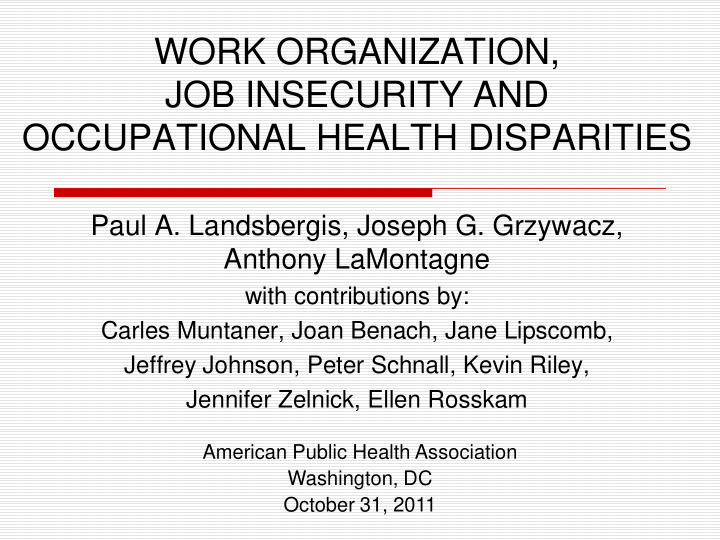



WORK ORGANIZATION, JOB INSECURITY AND OCCUPATIONAL HEALTH DISPARITIES Paul A. Landsbergis, Joseph G. Grzywacz, Anthony LaMontagne with contributions by: Carles Muntaner, Joan Benach, Jane Lipscomb, Jeffrey Johnson, Peter Schnall, Kevin Riley, Jennifer Zelnick, Ellen Rosskam American Public Health Association Washington, DC October 31, 2011
Presenter Disclosures Paul Landsbergis The following personal financial relationships with commercial interests relevant to this presentation existed during the past 12 months: No relationships to disclose
Changing Nature of Work in the Global Economy 3
Labor Stratification (high disparity risk): Race/Ethnicity, Immigration Status, Gender, Social Class, Age Employment Organizational Conditions Factors Formal/informal Downsizing, Job/Task- economy outsourcing, Occupational Specific Factors privatization of Mechanisms Health & Forced labor public services Physical, chemical, Safety biomechanical Physiological Child labor Supply chains, Outcomes hazards subcontracting Precarious/full-time Well-being Psychological Long work hours, permanent Temporary work Injury shiftwork employment Illness Behavioral Production systems Mortality Psychosocial job Unemployment stressors Safety Labor regulations culture/climate Unionization of Human resource workforce policies Industry/Sector: Agriculture, Construction, Healthcare, Transportation, other Figure 1. Conceptual overview of the role of work organization in the creation of occupational health disparities
How Job Insecurity & Work Organization Can Produce Occupational Health Disparities Differential exposure Greater exposure to job insecurity & work organization hazards in groups with less power: Lower socioeconomic positions, women, racial & ethnic minorities, immigrants, younger workers Differential vulnerability Greater effects of job insecurity & work organization hazards on health & safety in groups with less power 5
Job Insecurity But…….
Summary of studies on JOB INSECURITY & occupational health disparities Lower SES Female Racial & ethnic Younger workers workers minority workers, workers immigrants Differential (greater) + + + + exposure to job insecurity Differential (greater) + - - - vulnerability to job insecurity + or - = consistency of findings Shaded red = small number of studies (<5) 7
Other work organization hazards 8
Summary of studies on WORK ORGANIZATION HAZARDS & occupational health disparities Lower SES Female Racial & ethnic Younger workers workers minority workers, workers immigrants Differential (greater) + - + + exposure to work organization hazards Differential (greater) + - - - vulnerability to work organization hazards + or - = consistency of findings Shaded red = small number of studies (<5) 9
10
Strategies for Reducing Job insecurity and Work Organization Hazards National/international levels policies, laws, regulations and standards UK Health & Safety Executive 2004 Mgmt Standards: employer policies/procedures to deal with job stressors countries w/ stronger social protections (Scandinavia): narrower SES & gender differences in low job control weaker assoc. betw/ job stressors & depression Sx U.S. states: safe staffing levels, voluntary O/T California: new law prohibits “willfull misclassification” of employees as independent contractors 11
Strategies for Reducing Job insecurity and Work Organization Hazards Industry/organizational levels collective bargaining integrated occup. health-health promotion programs: benefits at both individual & organizational levels (for example, reducing rates of sickness absence) worker participation: feature of effective programs Maintenance Cooperation Trust Fund: identified labor abuses in retail chains that contracted janitorial services that failed to comply with labor laws developed legal cases, won >$26 million in back pay over 3 yrs 12
Strategies for Reducing Job insecurity and Work Organization Hazards Individual levels time management skills training no benefits seen at organizational level 13
Worker participation Worker groups with less power lower SES; temp workers, especially women; night shift less likely to: participate in such programs be represented in consultative forums (e.g., labor- management committees) less likely to complain about work hazards Programs need to focus on such workers 14
Case studies Low-wage workers classified as independent contractors Social service workers Civil aviation workers 15
Discussion questions What can employers, workers & labor unions do to: minimize exposure to work organization hazards such as temp work, low job control, work-family conflicts? reduce differences in exposure ― the higher levels of exposure to such hazards faced by lower income workers, racial & ethnic minority workers, younger workers, and, for some hazards, women workers? What challenges stand in the way of enacting local, state or Federal laws or regulations designed to minimize exposure to work organization hazards? 16
Discussion questions What research is needed to strengthen the evidence- base to answer: "do differences in work organization hazards between groups of workers contribute to occupational health disparities"? What issues or constraints need to be addressed to be able to conduct intervention research or research studies on work organization hazards with a strong ”translational” impact, that is studies that have a practical use in the workplace or when developing public policy? 17
We welcome feedback on: concepts research studies prevention programs recommendations 18 http://www.aoecdata.org/conferences/healthdisparities/synopses.html
Recommend
More recommend